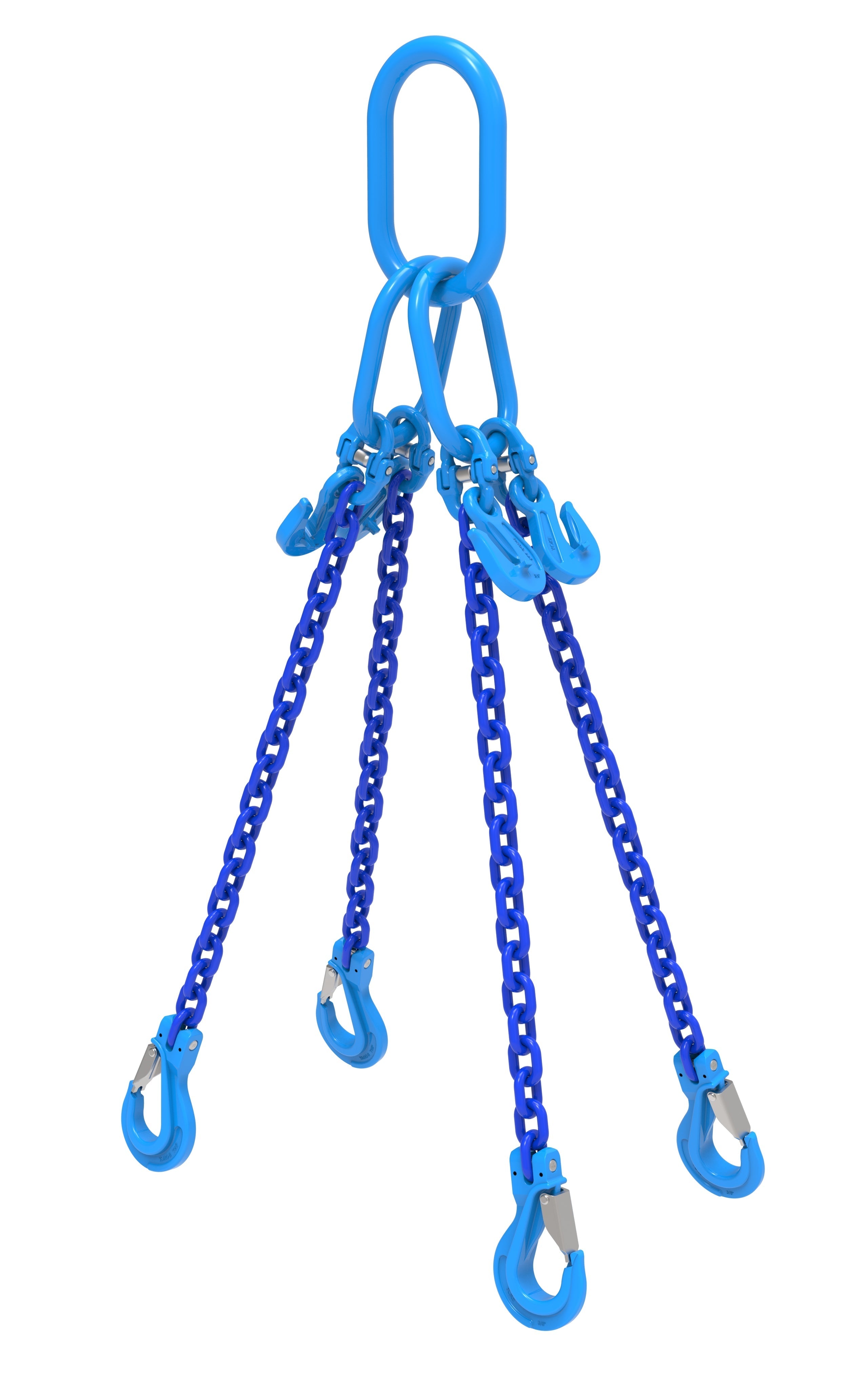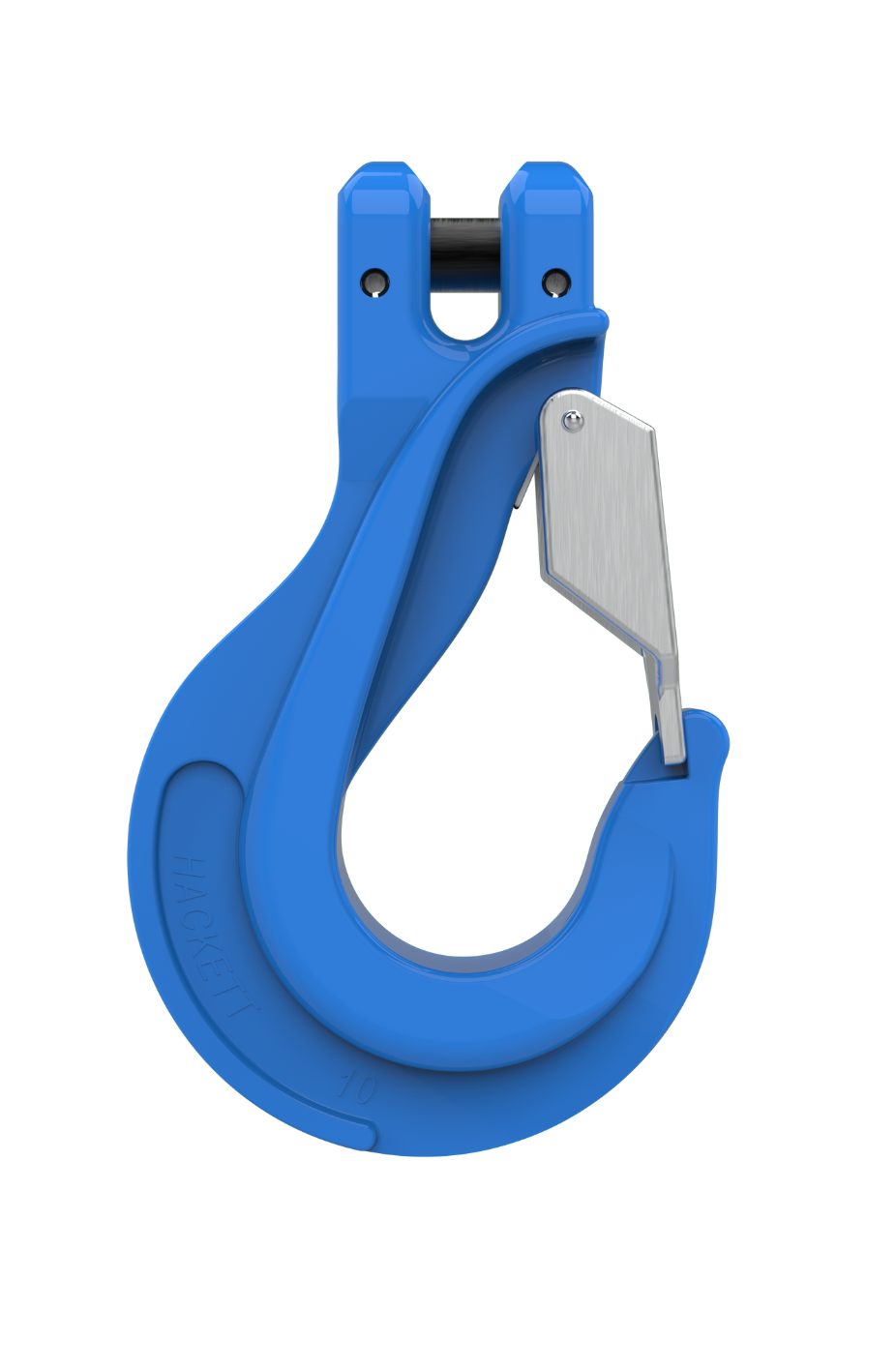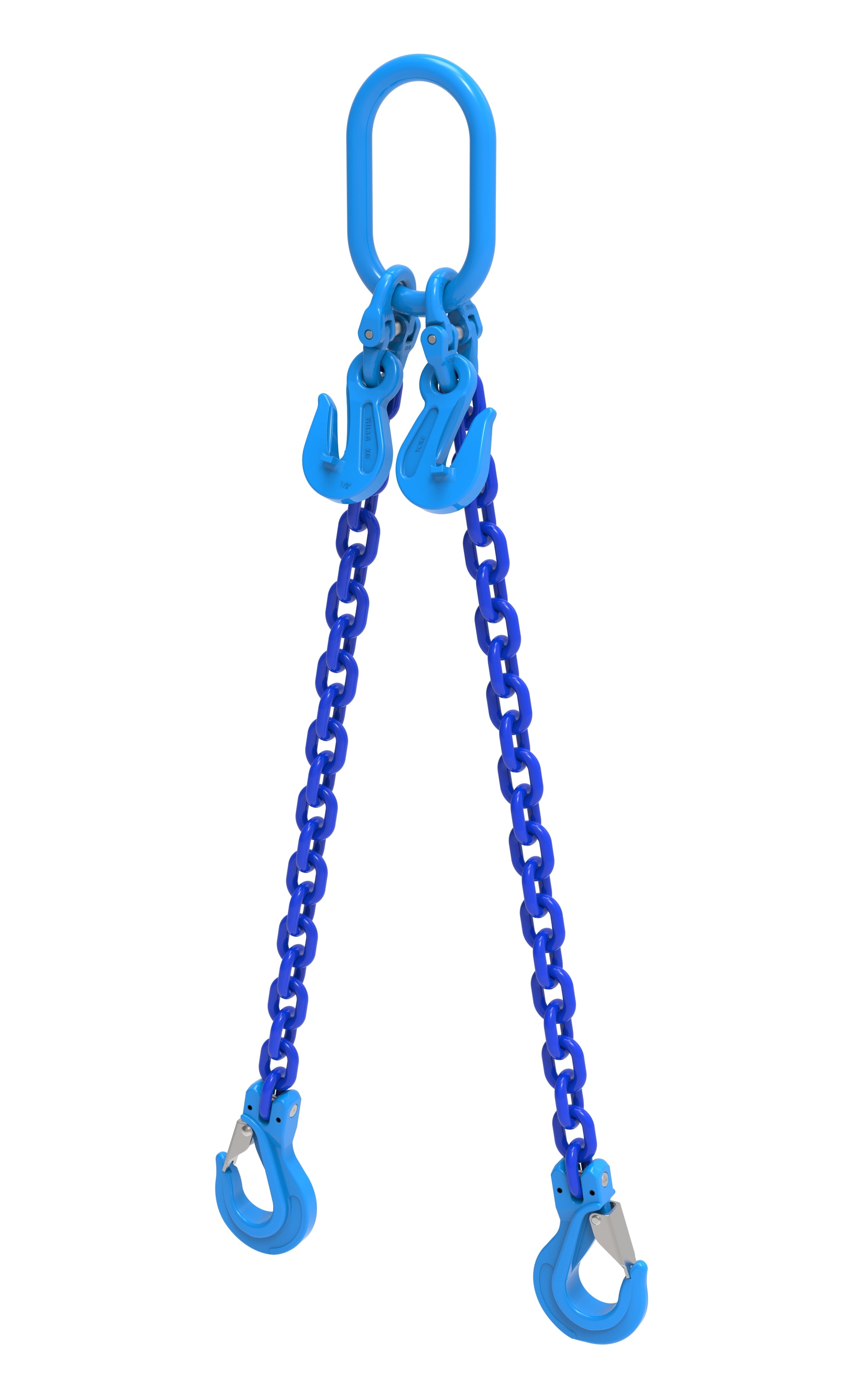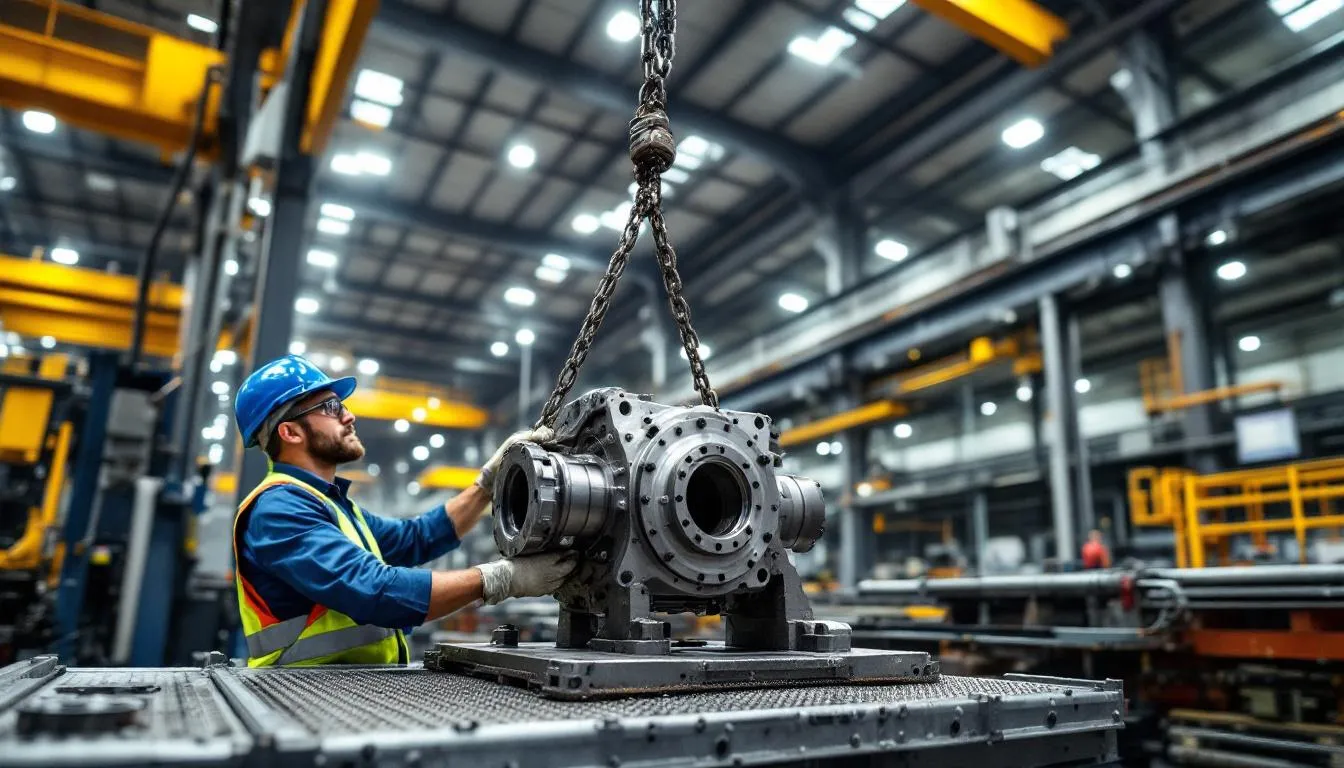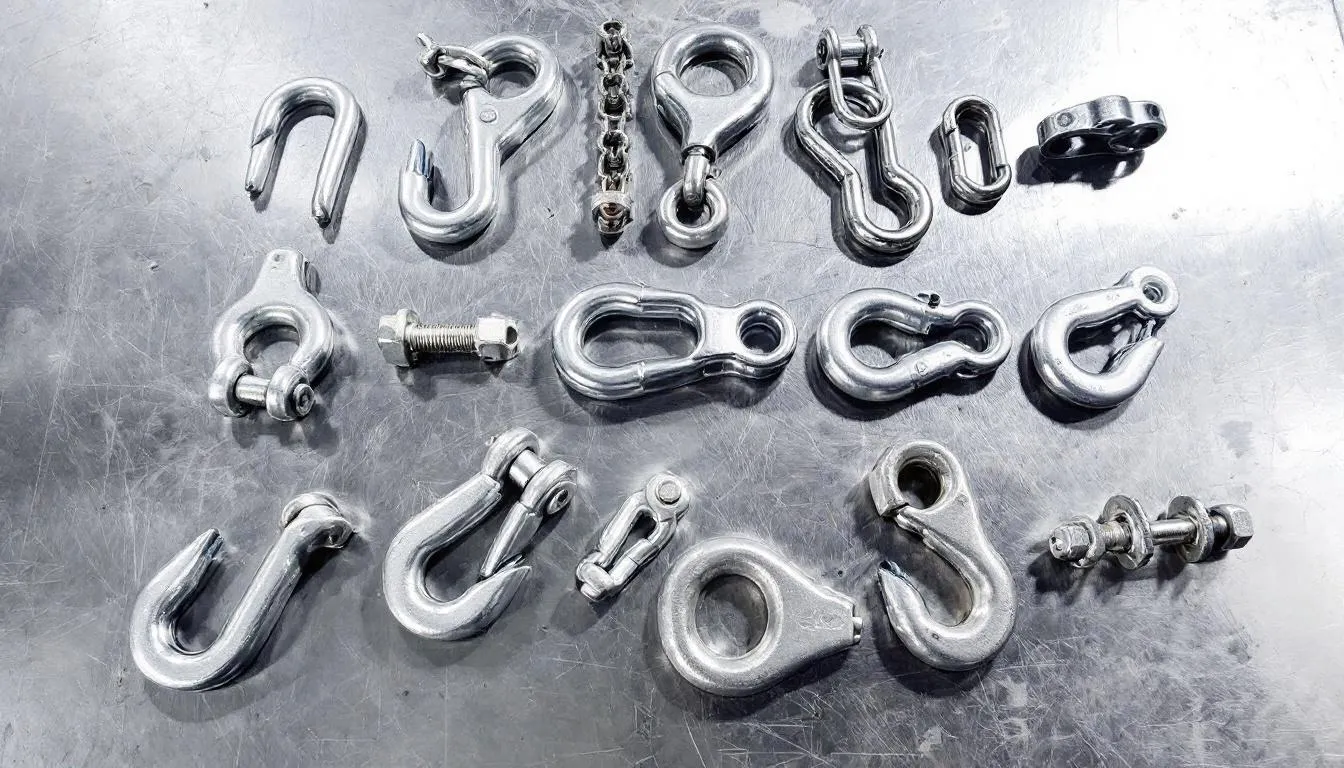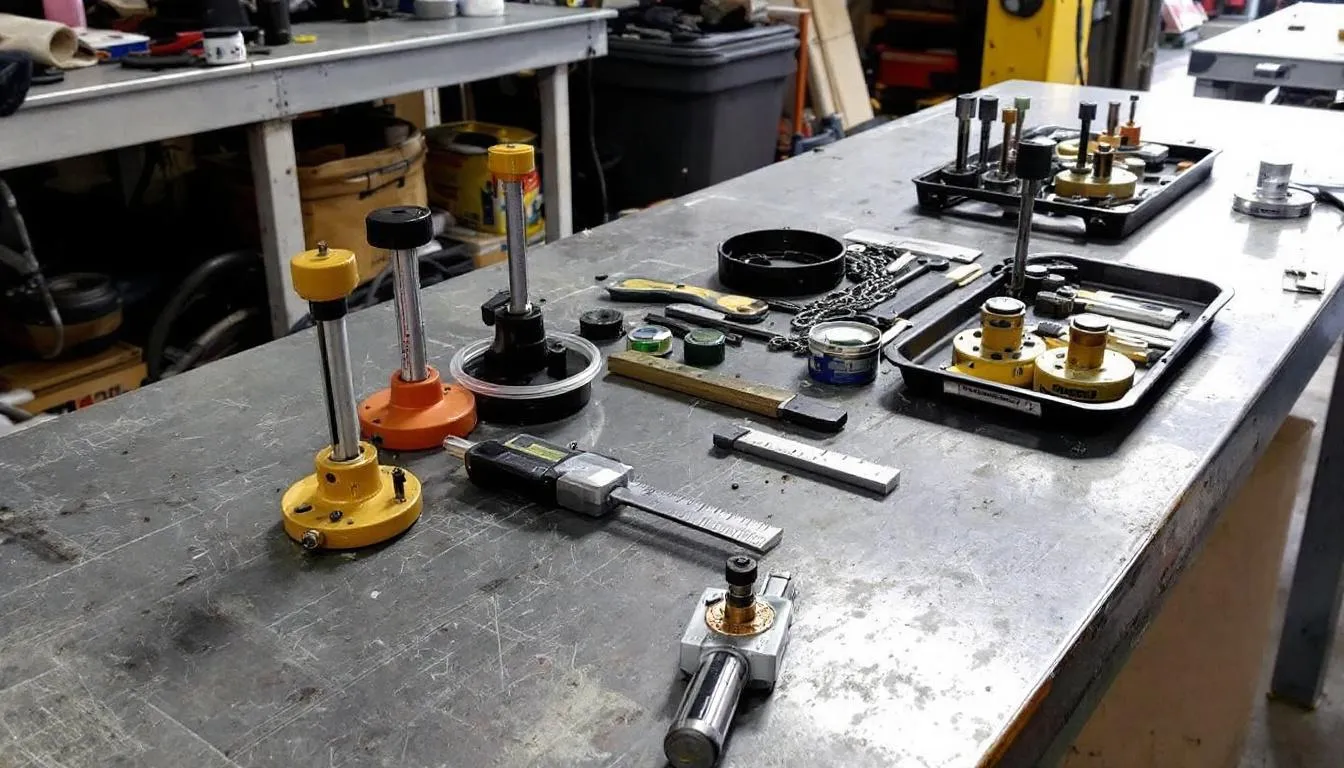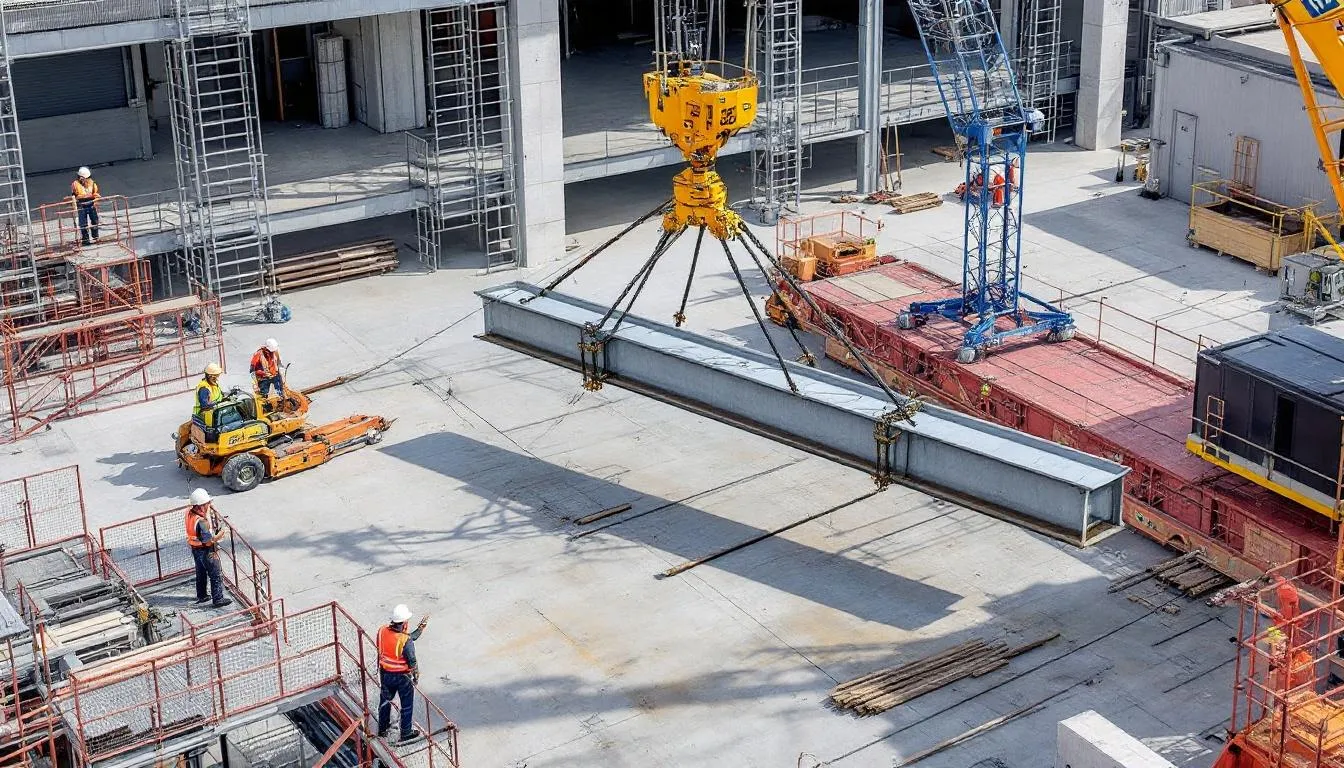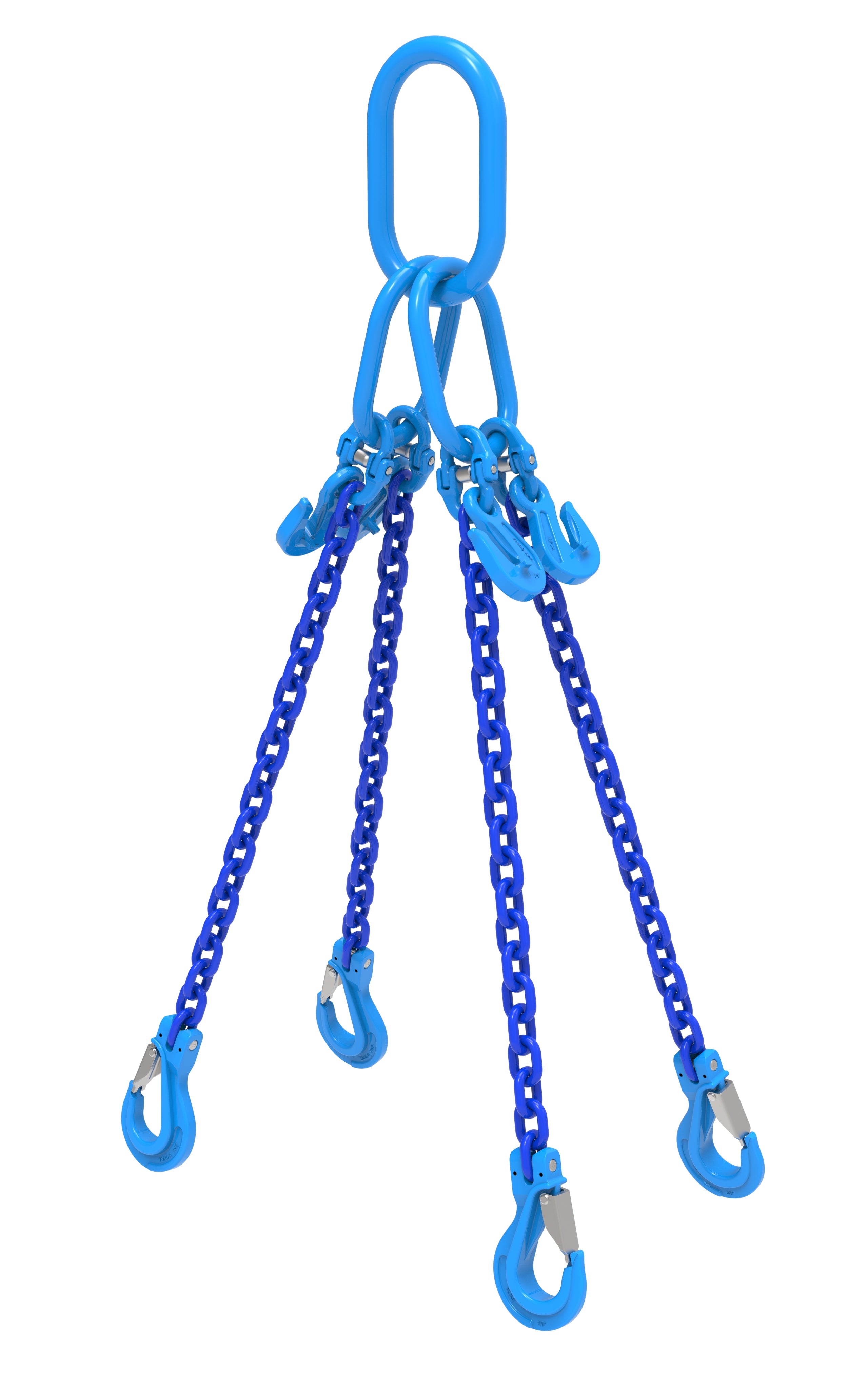Key Takeaways
-
Alloy steel chain slings are premium lifting equipment made from Grade 80 or Grade 100 steel, offering superior strength and durability for heavy-duty overhead lifting applications
- Available in single-leg to quad-leg configurations with various hook attachments to meet specific lifting requirements
- Resistant to high temperatures up to 1,000°F (538°C), abrasion, and harsh industrial environments
- Require daily visual inspections and periodic thorough inspections with maximum 12-month intervals
- Comply with OSHA, ANSI B30.9, and NACM safety standards for industrial lifting operations
- Offer adjustable length options and multiple attachment types for versatile lifting applications
When industrial lifting operations demand maximum strength, durability, and safety, alloy steel chain slings stand as the gold standard for heavy-duty applications. These specialized lifting devices combine high-strength alloy steel construction with precision engineering to deliver unmatched performance in the most demanding industrial environments.
Unlike standard carbon steel chains, alloy steel chain slings undergo rigorous heat treatment processes and are manufactured from carefully selected alloy compositions that provide superior tensile strength, fatigue resistance, and impact toughness. This makes them the preferred choice for overhead lifting in power plants, steel mills, construction sites, and other heavy industry applications where failure is not an option.
What Are Alloy Steel Chain Slings?
Alloy steel chain slings represent the pinnacle of heavy-duty lifting technology, engineered specifically for overhead lifting applications that demand exceptional strength and reliability. These lifting chains are fabricated from premium alloy steel materials and feature specialized end fittings designed to handle the most challenging lifting operations safely and efficiently.
The superior strength-to-weight ratio of alloy chain slings makes them significantly more practical than their carbon steel counterparts. This advantage translates to easier handling for workers while maintaining the robust lifting capacity required for heavy loads. The excellent conformability of these sling hooks allows them to adapt to irregular load shapes and surfaces, providing secure grip and load distribution that wire rope or synthetic alternatives cannot match.
Primary applications span across power generation facilities where turbine components require precise positioning, manufacturing plants handling heavy machinery, petroleum refineries moving reactor vessels, and construction projects involving structural steel placement. In these environments, the combination of strength, durability, and temperature resistance makes alloy steel chain slings indispensable.
The advantages over wire rope slings and synthetic lifting slings become apparent in harsh environments. While wire rope degrades under high temperatures and abrasive conditions, and synthetic materials can be cut or chemically damaged, alloy steel chains maintain their integrity and rated capacity even when exposed to extreme temperatures, sharp edges, and chemically active environments.
Grades and Material Properties
The foundation of any alloy steel chain sling lies in its material grade, which determines the working load limit, durability, and application suitability. Understanding these grades is crucial for proper selection and safe operation.
Grade 80 Alloy Steel Chain Specifications
Grade 80 alloy steel chain represents the industry standard for most overhead lifting applications. With a minimum break strength of approximately 800 MPa (116,000 psi), these lifting chains provide reliable performance across a wide range of industrial applications. The distinctive black armor protective finish not only provides enhanced abrasion resistance but also serves as visual identification for Grade 80 classification.
The heat treatment process for Grade 80 alloy chain involves precise quenching and tempering cycles that optimize the steel’s microstructure for maximum fatigue resistance. This process ensures that the chain can withstand repeated loading cycles without degradation, making it ideal for normal service conditions in industrial environments.
Grade 100 Enhanced Strength Characteristics
Grade 100 alloy steel chains offer approximately 25% higher working load limits compared to Grade 80 chains of identical dimensions. For example, a 5/16” Grade 80 chain with a 4,500 lb WLL would have a Grade 100 equivalent rated at 5,700 lbs. This increased capacity is achieved through advanced alloy compositions and refined heat treatment methods.
The European signal violet coating identification system helps distinguish premium Grade 100 chains from standard grades, providing immediate visual confirmation of the enhanced capacity rating. This coating also offers additional protection against corrosion and wear in severe service conditions.
Specialized Grade Options
Grade 120 alloy steel chains provide further strength-to-weight improvements for applications requiring maximum lifting capacity with minimal chain weight. While less common than Grade 80 and 100, these chains excel in applications where weight reduction is critical.
Grade 50 stainless steel options address specialized requirements where corrosion resistance takes priority over maximum strength. These chains perform well in chemically active environments where standard alloy steel might experience accelerated degradation.
|
Chain Size |
Grade 80 WLL |
Grade 100 WLL |
Grade 120 WLL |
|---|---|---|---|
|
5/16” |
4,500 lbs |
5,700 lbs |
6,600 lbs |
|
3/8” |
6,600 lbs |
8,800 lbs |
9,500 lbs |
|
1/2” |
11,250 lbs |
15,000 lbs |
16,500 lbs |
|
5/8” |
16,800 lbs |
22,600 lbs |
24,500 lbs |
|
3/4” |
23,000 lbs |
28,800 lbs |
33,500 lbs |
The chemical composition of alloy steel chains typically includes chromium, molybdenum, and nickel elements that enhance strength, toughness, and weldability. The precise heat treatment processes create a microstructure that delivers high fatigue resistance and the ability to survive dynamic loading conditions without brittle failure.
Chain Sling Configurations
The versatility of alloy steel chain slings extends beyond material properties to encompass various configurations designed to match specific lifting requirements and load geometries.
Single Leg Chain Slings
Single leg chain slings provide the most straightforward solution for basic lifting operations where loads can be lifted vertically with a single attachment point. These configurations offer the most cost-effective option while maintaining full rated capacity when used in vertical lifts. The simplicity of single-leg designs makes them ideal for routine maintenance operations and standard material handling tasks.
Double Leg Chain Slings
Double leg configurations distribute loads across two attachment points, providing improved load balance and stability during lifting operations. This configuration proves particularly valuable when lifting long or irregularly shaped objects that require two-point suspension for proper load control. The load distribution also reduces stress concentrations that might occur with single-point lifting.
Triple Leg Chain Slings
Triple leg chain slings offer enhanced stability for complex load distribution scenarios. The three-point suspension system provides redundancy and improved load control for irregularly shaped or off-center loads. These configurations excel in applications where load stability during transport is critical, such as machinery installation or heavy component positioning.
Quadruple Leg Chain Slings
Quadruple leg configurations provide maximum stability for the heaviest and most challenging lifting applications. The four-point suspension system distributes loads evenly and provides multiple redundancy levels for critical lifts. These slings are commonly specified for lifting large transformers, reactor vessels, and other equipment where absolute stability is required.
The master link serves as the central connection point for multi-leg slings and must be rated to handle the combined loading from all legs. Proper master link selection requires consideration of load angles and potential load distribution imbalances that can increase stress beyond simple additive calculations.
Custom configurations address specialized lifting requirements that standard slings cannot accommodate. These may include specific leg lengths, specialized attachment hardware, or unique geometries required for particular applications. Custom chain slings require careful engineering analysis to ensure proper load distribution and safety factors.
Attachment Options and Hardware
The effectiveness of any alloy chain sling depends heavily on the quality and suitability of its attachment hardware. Each component must match or exceed the chain’s rated capacity while providing secure, reliable connection to both the lifting equipment and the load.
Sling Hooks for General Purpose Applications
Standard sling hooks represent the most common attachment option for general purpose lifting applications. These hooks feature safety latches that prevent accidental disconnection during lifting operations. The latch mechanism must be inspected regularly to ensure proper function, as hook openings that exceed 15% of original dimensions or latches that fail to close properly render the sling unsafe for service.
Grab Hooks for Adjustable Length Setups
Grab hooks provide unique advantages in adjustable length chain sling configurations. These hooks can be repositioned along the chain length to accommodate varying lifting requirements without requiring multiple slings. The ability to quickly adjust working lengths makes grab hooks particularly valuable in maintenance operations where lifting points may vary between jobs.
The grab hook design allows the hook to grip any link in the chain, but proper engagement requires attention to load direction and hook orientation. Improper grab hook positioning can create stress concentrations that reduce the effective working load limit of the entire sling.
Foundry Hooks for Heavy Applications
Foundry hooks feature oversized openings and robust construction designed specifically for heavy, irregularly shaped loads common in foundry and steel mill operations. The enlarged throat opening accommodates thick lifting lugs and provides clearance for loads with limited access. These hooks often feature reinforced construction to handle the severe service conditions typical in high-temperature environments.
Self-Locking Hook Safety Features
Self locking hook designs provide enhanced security through automatic locking mechanisms that engage when loads are applied. The safety latch on these hooks closes and locks automatically, preventing accidental release even if the latch mechanism is inadvertently contacted during lifting operations. This feature proves particularly valuable in overhead lifting applications where human body contact with the load or rigging is possible.
Master Links and Connecting Hardware
Master links serve as the central collection point for multi-leg slings and must be sized with adequate capacity to handle the combined loading from all sling legs. The rated load calculation for master links must account for load angles that can significantly increase stress beyond simple load addition.
Capacity matching between the alloy chain and all attachment hardware ensures that the weakest component doesn’t compromise the entire sling’s performance. Each piece of hardware must be proof tested and permanently marked with capacity ratings and manufacturer identification.
Safety Standards and Compliance
Compliance with established safety standards forms the foundation of safe alloy steel chain sling operation. Multiple regulatory bodies have developed comprehensive requirements that govern design, manufacturing, inspection, and use of these critical lifting devices.
OSHA Regulations for Overhead Lifting
OSHA regulations establish fundamental requirements for overhead lifting operations, including mandatory training for personnel involved in rigging operations. These regulations require that only qualified persons conduct lifting operations and that all equipment be inspected before use. The regulations also mandate that employers provide proper training and ensure workers understand the limitations and proper use of lifting equipment.
Daily visual inspections must be performed by the operator before each use, checking for visible damage, wear, or defects that could compromise safety. Any sling showing signs of damage must be removed from service immediately until proper evaluation and potential repair can be completed.
ANSI B30.9 Standard Requirements
ANSI B30.9 provides comprehensive guidance for sling design, selection, and use, including specific requirements for labeling and proof testing. This standard establishes the framework for proper sling identification, including permanent tags that display grade, size, number of legs, working load limits at various angles, and manufacturer information.
The standard requires that illegible sling identifications render the equipment unserviceable, emphasizing the critical importance of maintaining readable identification throughout the sling’s service life. Replacement identification tags must contain identical information to original tags and be installed according to manufacturer’s recommendations.
NACM Manufacturing Specifications
The National Association of Chain Manufacturers (NACM) establishes manufacturing and performance criteria for lifting chains, including material specifications, heat treatment requirements, and quality control procedures. These specifications ensure consistent quality and performance across different manufacturers while establishing minimum standards for traceability and documentation.
NACM specifications require that each link be permanently marked with grade identification, typically showing symbols like A8 for Grade 80 or international “T” symbols for lifting chain designation. These markings must appear at least once per foot of chain length to ensure traceability throughout the chain’s service life.
Required Identification and Certification
Every alloy steel chain sling must include permanent identification that provides essential information for safe operation. This identification typically includes chain grade, working load limits at various sling angles, number of legs, manufacturer identification, and serial numbers that link to manufacturing and testing records.
Proof testing certificates must accompany each sling, documenting that the complete assembly has been tested to twice its working load limit. These certificates provide traceability to manufacturing records and proof test results, which may be required for regulatory compliance or insurance purposes.
The testing process involves applying loads equal to twice the working load limit while measuring chain elongation to ensure it remains within specified limits. Chains that stretch beyond acceptable limits during proof testing are rejected, ensuring that only slings meeting strict quality standards enter service.
Inspection and Maintenance Requirements
Systematic inspection and maintenance programs are essential for maintaining the safety and reliability of alloy steel chain slings throughout their service life. These programs must address both routine operational checks and comprehensive periodic evaluations.
Daily Visual Inspection Procedures
Daily visual inspections form the first line of defense against equipment failure. Operators must examine the entire sling before each use, checking for stretched links, worn spots, cracks, corrosion, heat damage indicated by blueing or discoloration, nicks, gouges, and missing or damaged safety latches on hooks.
Particular attention must be paid to areas of high stress concentration, such as the connection points between chain and hardware. These areas experience the highest loads and are most susceptible to fatigue damage. Any signs of permanent deformation, including stretched links or opened chain dimensions, require immediate removal from service.
The sling body must be inspected along its entire length, with special attention to areas that contact the load or lifting equipment. Abrasive surfaces can cause gradual wear that may not be immediately apparent but can significantly reduce the sling’s load capacity over time.
Periodic Thorough Inspection Requirements
Thorough inspections must be conducted at intervals not exceeding 12 months, with more frequent inspections required for severe service use or when service conditions warrant additional scrutiny. These inspections must be performed by qualified personnel and documented with detailed records of findings and any corrective actions taken.
The inspection process includes dimensional measurements using “No-Go” gauges to check whether chain wear exceeds manufacturer-specified limits. Typically, diameter reductions exceeding 10% of original dimensions require sling removal from service. Chain stretch measurements over 10-20 link segments help identify gradual elongation that may indicate overloading or material degradation.
Hook deformation measurements must verify that throat openings haven’t increased more than 15% beyond original dimensions and that twist deformation doesn’t exceed 10 degrees. These measurements require precise tools and techniques to ensure accurate assessment of hook condition.
Documentation and Record Keeping
Inspection records must be maintained throughout the sling’s service life, providing a historical record of condition and performance. These records help identify trends that might indicate accelerated wear or inappropriate use patterns. Documentation should include inspection dates, inspector identification, specific findings, and any corrective actions taken.
When slings require removal from service, records should document the specific defects identified and the disposition of the equipment. This information helps identify patterns that might indicate systemic issues with application, environment, or maintenance practices.
Performs additional periodic inspections may be required in environments where accelerated wear or damage is expected. The frequency of these additional inspections should be based on actual service experience and manufacturer’s recommendations for specific operating conditions.
Environmental Considerations and Temperature Limits
Understanding environmental limitations and temperature effects is crucial for proper alloy steel chain sling selection and safe operation. Different operating conditions can significantly impact sling performance and service life.
Maximum Temperature Exposure Guidelines
Alloy steel chains can operate safely at temperatures up to 1,000°F (538°C), making them suitable for many high-temperature industrial applications. However, load capacity reductions become necessary when operating temperatures exceed 400°F (205°C). These derating factors typically reduce working load limits to 80% of rated capacity at 600°F, with further reductions at higher temperatures.
The ability to lift hot materials safely distinguishes alloy steel chain slings from wire rope alternatives, which typically experience significant strength degradation at much lower temperatures. This capability makes alloy chain slings essential for foundry operations, steel mill maintenance, and other applications involving extreme temperatures.
Temperature exposure history affects chain properties, so slings used in high-temperature applications require more frequent inspection to identify any heat-related degradation. Discoloration, scaling, or other signs of heat damage indicate potential strength reduction and may require capacity derating or equipment replacement.
Chemical Resistance Properties
While alloy steel chains offer better chemical resistance than standard carbon steel, exposure to strong acids, alkalis, or other corrosive substances can necessitate special consideration. Stainless steel grades may be required for severely corrosive environments, though these typically offer lower working load limits than standard alloy grades.
Chemically active environments require evaluation of both the chain material and all hardware components to ensure compatible resistance levels. The weakest component in terms of chemical resistance determines the sling’s suitability for specific environments.
Regular inspection frequency should be increased in chemically active environments, as corrosion damage can progress rapidly under certain conditions. Visual inspection may not reveal the full extent of chemical damage, so periodic professional evaluation may be necessary.
Storage Requirements and Environmental Protection
Proper storage prevents mechanical damage and corrosion that can compromise sling integrity. Chain slings should be stored in dry, clean locations away from chemicals and protected from prolonged weather exposure. Hanging storage prevents kinking and mechanical damage that can occur when slings are stored in piles.
UV exposure doesn’t directly affect steel chains, but protective coatings may degrade under prolonged sunlight exposure. Storage areas should provide protection from direct weather while allowing air circulation to prevent moisture accumulation.
The storage environment should prevent contact with dissimilar metals that might cause galvanic corrosion. Concrete floors or surfaces treated with acidic materials should be avoided to prevent chemical attack on chain surfaces.
Proper Selection and Ordering Guidelines
Selecting the appropriate alloy steel chain sling requires careful analysis of multiple factors, including load characteristics, environmental conditions, and safety requirements. Proper specification ensures optimal performance and maximizes equipment service life.
Load Weight Calculation and Safety Factors
Accurate load weight determination forms the foundation of proper sling selection. The calculated load must include not only the static weight but also any dynamic factors that might increase loading during lifting operations. Industry standard safety factors of 4:1 or higher ensure adequate margin for load variations and unexpected conditions.
When multiple slings share a load, the distribution may not be equal due to geometric factors or load center variations. Conservative design practice assumes that any single sling in a multi-sling lift might carry a disproportionate share of the total load.
Dynamic loading from shock loading, sudden stops, or equipment vibration can significantly increase actual loads beyond static calculations. These factors must be considered in the selection process, particularly for applications involving mobile equipment or frequent load movement.
Environmental Assessment for Grade Selection
The operating environment directly influences proper grade selection. High-temperature applications may require Grade 100 or specialized materials to maintain adequate capacity after temperature derating. Corrosive environments might necessitate stainless steel grades despite reduced load capacity.
Abrasive environments favor alloy steel chains over synthetic alternatives due to their superior abrasion resistance. The ability to withstand contact with sharp edges and rough surfaces makes alloy chains particularly suitable for construction and heavy industry applications.
Service conditions that involve frequent loading cycles benefit from the fatigue resistance of higher-grade alloy steels. Applications with infrequent service may not justify the premium cost of advanced grades.
Configuration Selection and Custom Requirements
Load geometry and available attachment points determine the optimal sling configuration. Single-leg slings provide the most economical solution for simple vertical lifts, while multi-leg configurations offer better load control for complex shapes.
The lifting beam arrangement affects load distribution and required sling angles. Angles less than 60 degrees from vertical significantly increase tension in individual sling legs and may require larger capacity slings or different configurations.
Custom chain slings address specialized requirements that standard configurations cannot accommodate. Custom orders typically require longer lead times and may involve engineering analysis to ensure proper design for specific applications.
Required information for custom orders includes precise length requirements, attachment types and orientations, environmental conditions, and any special marking or certification requirements. Complete application information helps manufacturers provide optimal solutions for specific needs.
Rigging Best Practices and Safety
Safe and effective use of alloy steel chain slings requires adherence to established rigging practices and thorough understanding of proper techniques. Improper rigging practices can lead to equipment failure, property damage, and serious injury.
Proper Hitching Techniques for Load Control
The basket hitch provides excellent load stability by wrapping the sling around the load, with both legs supporting the weight. This configuration offers good load control and prevents slippage when properly applied. The load must be positioned to prevent point loading on chain links, which can cause premature failure.
Choker hitch configurations use the sling’s ability to tighten around the load for secure lifting. The choke point must be positioned to prevent slippage while avoiding sharp edges that might damage the chain. Proper choker hitch application requires understanding of the reduced capacity that results from the acute angle at the choke point.
Vertical hitches provide maximum rated capacity but require secure attachment points and proper load balance. This configuration works best with loads that have designated lifting points and stable geometry.
Load Analysis for Multiple-Leg Slings
Multiple-leg slings require careful analysis of load distribution and sling angles. Uneven load distribution can result in individual slings carrying more than their proportional share of the total weight. This condition becomes critical when sling angles differ or when the load center doesn’t align with the rigging geometry.
Sling angles significantly affect individual leg tension. As angles decrease from vertical, tension in each leg increases dramatically. At 60 degrees from vertical, each leg carries approximately 115% of its proportional share. At 45 degrees, this increases to 140%, requiring capacity adjustments in sling selection.
The manner providing control during lifting operations requires coordination between all personnel involved. Clear communication protocols and predefined hand signals help ensure safe execution of complex lifts.
Personnel Safety and Communication Protocols
Qualified personnel must oversee all rigging operations, with clear definition of responsibilities and authority. The rigging supervisor should have direct control over the lifting operation and authority to stop the lift if unsafe conditions develop.
Body positioning during lifting operations requires maintaining safe distances from suspended loads and potential swing paths. The human body should never be used as a positioning tool or placed in potential crush points during load movement.
Communication during lifting operations must be clear and unambiguous. Standard hand signals or radio protocols help ensure that all team members understand lift commands and can respond appropriately to changing conditions.
Preventing point loading requires attention to load contact surfaces and sling positioning. Sharp edges or small contact areas can create stress concentrations that exceed material limits even at loads well below rated capacity.
Advantages Over Alternative Lifting Methods
Alloy steel chain slings offer distinct advantages over other lifting methods in many applications, though each technology has its appropriate uses based on specific requirements and operating conditions.
Superior Abrasion Resistance Compared to Synthetic Slings
The better abrasion resistance of alloy steel chains makes them ideal for applications involving contact with rough or sharp surfaces. While synthetic slings may be cut or abraded by contact with abrasive surfaces, steel chains maintain their integrity and load capacity. This durability translates to longer service life and reduced replacement costs in demanding environments.
Construction applications frequently involve lifting materials with sharp edges or rough surfaces that would quickly damage synthetic alternatives. Steel production and foundry operations present similar challenges where abrasion resistance is essential for safe operation.
The ability to withstand repeated contact with load surfaces without degradation makes alloy chains particularly cost-effective for applications involving frequent lifting of similar loads. The consistent performance throughout the service life provides predictable operating costs and reduced downtime for equipment replacement.
Heat Resistance Advantages Over Wire Rope
Wire rope slings experience significant capacity reduction at temperatures above 400°F and may suffer permanent damage from high-temperature exposure. Alloy steel chains maintain their structural integrity up to 1,000°F, though capacity derating is required at elevated temperatures.
This temperature capability makes alloy chains essential for foundry operations, steel mill maintenance, and other applications where hot materials must be handled safely. The ability to cool down and return to full capacity after temperature exposure provides operational flexibility not available with heat-damaged wire rope.
Power plant maintenance operations often require lifting components that retain heat from normal operation. Alloy steel chains can handle these applications safely while wire rope alternatives might require extended cooling periods or special protection.
Adjustable Length Capabilities and Versatility
Grab hook configurations allow quick length adjustment to accommodate varying lifting requirements without requiring multiple slings. This adjustability proves particularly valuable in maintenance operations where lifting points may vary between jobs or where precise positioning is required.
The ability to quickly reconfigure sling lengths reduces inventory requirements and provides operational flexibility. A single adjustable sling can replace multiple fixed-length alternatives, reducing storage space and inventory costs.
Custom configurations can address specialized lifting requirements that standard alternatives cannot accommodate. The modularity of chain construction allows for complex rigging arrangements that provide optimal load distribution for irregular shapes.
Long Service Life and Cost-Effectiveness
The durability of alloy steel chains under repeated loading cycles provides excellent return on investment despite higher initial costs. Proper maintenance can extend service life for many years, even under demanding operating conditions.
Resistance to cutting and puncture damage eliminates many of the failure modes that affect synthetic alternatives. This reliability reduces the risk of unexpected equipment failure and associated downtime costs.
The ability to recondition certain components, such as replacing worn hardware while retaining serviceable chain, can extend overall sling life and reduce replacement costs. This repairability is not available with synthetic slings that must be completely replaced when damaged.
Industry Applications and Use Cases
Alloy steel chain slings serve critical roles across numerous industrial sectors where heavy lifting capabilities, environmental resistance, and safety are paramount considerations.
Power Plant Maintenance and Heavy Equipment Handling
Power generation facilities rely on alloy steel chain slings for turbine maintenance, generator positioning, and component replacement operations. The combination of high load capacity and temperature resistance makes these slings essential for handling components that may retain operational heat.
Reactor maintenance in nuclear facilities requires lifting equipment that meets strict quality and traceability standards. The certification and documentation capabilities of alloy steel chain slings support these regulatory requirements while providing the reliability needed for critical operations.
Wind turbine installation and maintenance operations use large-capacity chain slings to position nacelles, rotors, and tower sections. The wind and weather resistance of steel construction provides reliable performance in outdoor environments where synthetic alternatives might degrade.
Steel Mill and Foundry High-Temperature Operations
Steel production facilities use alloy steel chain slings throughout the manufacturing process, from raw material handling to finished product movement. The extreme temperatures and abrasive conditions in these environments require the durability that only alloy steel construction can provide.
Foundry operations involve frequent lifting of hot castings and molds where temperature resistance is essential. The ability to lift hot materials safely without capacity degradation makes alloy chains indispensable for these applications.
Rolling mill operations require lifting equipment that can withstand the severe service conditions while providing precise load control. The strength and durability of alloy chains support the demanding requirements of continuous production operations.
Petroleum Refinery and Chemical Plant Operations
Refinery maintenance operations involve lifting heavy reactors, heat exchangers, and piping systems that may operate at elevated temperatures. The chemical resistance and temperature capability of alloy steel chains make them suitable for these challenging environments.
Reactor vessel installation requires heavy-duty lifting equipment capable of handling massive loads with absolute reliability. The high working load limits and proven performance of alloy chains provide the confidence needed for these critical operations.
Pipeline construction projects use chain slings for positioning large-diameter pipe sections and related equipment. The adjustability and load capacity of these slings support efficient installation operations in diverse terrain conditions.
Construction and Infrastructure Projects
Heavy construction operations rely on alloy steel chain slings for lifting structural steel, precast concrete sections, and heavy equipment. The durability and load capacity make these slings essential for projects involving massive components.
Bridge construction requires lifting equipment capable of handling long spans and heavy sections with precise positioning. The stability and control provided by multi-leg chain sling configurations support these demanding applications.
Infrastructure rehabilitation projects often involve lifting and positioning heavy components in restricted spaces. The flexibility and strength of alloy chain slings enable these operations while maintaining safety standards.
Shipbuilding and Marine Industry Applications
Shipyard operations use heavy-duty lifting applications for positioning engines, propellers, and structural sections. The corrosion resistance and strength of alloy steel chains provide reliable performance in marine environments.
Offshore construction projects require lifting equipment that can withstand harsh environmental conditions while handling heavy loads. The durability of alloy construction supports these demanding applications.
Marine salvage operations often require lifting equipment capable of handling unknown loads under difficult conditions. The reliability and strength margin of alloy steel chain slings provide confidence for these critical operations.
FAQ
What is the difference between Grade 80 and Grade 100 alloy steel chain slings?
Grade 100 alloy steel chain slings offer approximately 25% higher working load limits compared to Grade 80 chains of the same size. For example, a 5/16” Grade 80 chain might have a 4,500 lb working load limit, while the equivalent Grade 100 chain would be rated at 5,700 lbs. This increased capacity results from improved alloy compositions and refined heat treatment processes that enhance material strength without increasing chain dimensions.
How often should alloy steel chain slings be inspected?
Alloy steel chain slings require daily visual inspections before each use, checking for obvious damage, wear, or defects. Additionally, thorough inspections must be conducted by qualified personnel at intervals not exceeding 12 months. Applications involving severe service conditions may require more frequent thorough inspections based on actual operating experience and manufacturer’s recommendations.
What is the maximum temperature rating for alloy steel chain slings?
Alloy steel chain slings can operate safely at temperatures up to 1,000°F (538°C). However, capacity derating becomes necessary when operating temperatures exceed 400°F (205°C). Typical derating factors reduce working load limits to approximately 80% of rated capacity at 600°F, with further reductions required at higher temperatures according to manufacturer specifications.
Can alloy steel chain slings be repaired if damaged?
Repairs to alloy steel chain slings are strictly limited by industry standards. Chain links cannot be welded, heat-treated, or otherwise repaired - damaged chain sections must be replaced entirely. Certain hardware components like hooks and master links may be replaceable, but such repairs must be performed by qualified personnel according to manufacturer procedures and documented appropriately.
What safety factors are built into alloy steel chain sling working load limits?
Alloy steel chain slings incorporate safety factors of 4:1 or higher, meaning the ultimate breaking strength is at least four times the working load limit. This substantial safety margin accounts for dynamic loading, manufacturing variations, and service-related wear while providing confidence for safe lifting operations under normal service conditions.
How do I determine the correct chain sling configuration for my lifting application?
Proper sling selection requires analysis of load weight, geometry, attachment points, and environmental conditions. Single-leg slings work for simple vertical lifts, while multi-leg configurations provide better stability for complex loads. Consider load distribution, required sling angles, and attachment hardware when selecting configuration. Consult with qualified rigging professionals or sling manufacturers for complex applications.
What documentation is required for alloy steel chain sling certification?
Each alloy steel chain sling must include permanent identification tags showing grade, size, working load limits, and manufacturer information. Additionally, proof testing certificates documenting that the sling has been tested to twice its working load limit must accompany each unit. These documents provide traceability to manufacturing records and support regulatory compliance requirements.
How should alloy steel chain slings be stored when not in use?
Store chain slings in clean, dry locations protected from chemical exposure and prolonged weather. Hang slings to prevent kinking and mechanical damage that can occur when stored in piles. Avoid contact with concrete floors or surfaces treated with acidic materials. Ensure adequate air circulation to prevent moisture accumulation while protecting from direct UV exposure that might degrade protective coatings.
Alloy steel chain slings represent the gold standard for heavy-duty lifting applications where strength, durability, and safety cannot be compromised. Their superior performance in extreme temperatures, abrasive environments, and demanding service conditions makes them indispensable across numerous industrial sectors. While the initial investment may exceed alternative lifting methods, the combination of long service life, consistent performance, and unmatched reliability provides exceptional value for critical lifting operations.
The key to maximizing the benefits of alloy steel chain slings lies in proper selection, rigorous inspection programs, and adherence to established safety practices. By understanding the capabilities and limitations of these sophisticated lifting tools, industrial professionals can ensure safe, efficient operations while minimizing equipment costs and downtime risks.

